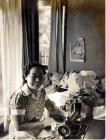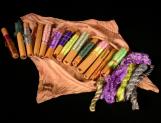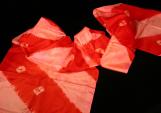1
Our Mothers' Patterns: Sewing and Dressmaking in the Japanese Canadian Community / by Susan Sirovyak2
Haruko Kobayakawa at her sewing machine, ca. 1950s, (in Toronto ?). Haruko Kobayakawa Fonds, JCNM.1950
Vancouver, BC

3
As did all women from all immigrant communities, pioneer Japanese Canadian women who came to Canada faced many challenges in the struggle to make new lives for themselves and their families. Most of the Issei (first-generation Japanese Canadian) women, immigrated to Canada in the 1910s and 1920s, joining husbands who had been labouring in many of British Columbia's primary industries. From the time of their first arrival, the women worked outside of the home on farms, in canneries, or as domestics to supplement their household income. A significant number of first and second-generation Japanese Canadian women also worked as dressmakers and/or owned dressmaking businesses. The contributions made by these women in the early years, the World War II period of upheaval, and the later re-establishment years were considerable. This article examines the experiences and contributions of these dressmakers, shedding light on a little known and previously undocumented area of Japanese Canadian history and heritage.4
Spools of silk thread brought from Japan by Maki Kudo around 1900, wrapped in a silk furoshiki cloth1900
Vancouver, BC

5
In the summer of 1996, myself, other staff, and volunteers of the Japanese Canadian National Museum & Archives (see endnote 1; additional end notes numbered in parentheses) had the opportunity to prepare a small exhibition on the role of dressmaking in the history of the Nikkei (2) community. Created through a series of interviews, discussions and correspondences with Japanese Canadian women who shared their memories and knowledge about sewing and dressmaking, the exhibition was entitled "Our Mothers' Patterns: Sewing and Dressmaking in the Japanese Canadian Community." From stories of long days over a sewing machine, photographs of sewing classes, and tiny mock-up patterns assembled from brown kraft paper, we began to piece together a picture of dressmaking in the Japanese Canadian community. We also began to realize the vital role that sewing and dressmaking has played in the lives of Japanese Canadian women and in the social fabric of the community. Almost everyone we spoke with had a mother, grandmother, sister, aunt or friend who learned to sew and acquired dressmaker's skills in the decades preceding World War II. As one woman, Kay Tatebe, said of that era: "There was a dressmaker on every corner and most of them were Japanese."(3)6
A square, ruler, and French curve used by Miyoko Takeuchi for dressmaking from the 1930s on.1930
Vancouver, BC

7
Why was sewing and dressmaking so popular in the Japanese Canadian community? Part of the reason, explains historian Dr. Michiko (Midge) Ayukawa, may be traced to Japan where sewing was considered to be part of the basic preparation for marriage for all young women. In an article she wrote for the Museum & Archive's newsletter, Dr. Ayukawa discussed the traditional role that Yoosai, or western sewing, played:"For centuries, in Japan, one of the basic skills that a young woman had to have before marriage, no matter how humble the home, was the ability to sew a kimono. In the rural areas, many started with the raw silk or cotton, made the thread, and dyed and wove the cloth. With the Meiji Restoration and the introduction of western style clothes, Yoosai often also became a necessary preparation for marriage. In Canada, too, this tradition has continued."(4)
8
Piece of silk salvaged from a kimono brought to Canada from Japan (nee Watanabe)1928
Fukui Prefecture, Japan
 Credits:
Credits:Masaye Sato.
9
The tradition not only continued, it flourished. From the 1910s to the 1930s, dressmaking in Canada was much more than a basic skill for prospective brides; it was one of the primary means by which Nikkei women earned their living. To understand the impact of dressmaking in the community, it is important to realize that for a young Japanese Canadian woman entering the work force at that time, there were very few opportunities for employment. Regardless of whether they had completed high school or university, Japanese Canadians were prevented from entering many occupations, due to social discrimination and the lack of franchise. For a young Nikkei woman entering the work force, positions in teaching, nursing or office work were impossible or extremely difficult to obtain. Most businesses did not hire Japanese workers, and while it was possible to find employment at a Japanese Canadian-based business or shop, these opportunities were very few.11
Thus, sewing and dressmaking was an attractive option that offered a reliable and secure way for Nikkei women to make a living. This was especially so for the Nisei, the second generation of Japanese Canadian women who began entering the job market in the 1920s and 1930s. According to a 1935 "Survey of the Second Generation Japanese in British Columbia", 85 of 261 female respondents living in urban areas listed dressmaking as their occupation.(5) And although most women in rural areas worked on farms or in fruit canneries, many were dressmakers. Of a total of 254 rural area respondents, there were 150 farm hands, 69 fruit cannery workers and 13 dressmakers, leaving only 22 respondents who listed themselves in any other occupation.12
Sewing School in Vancouver, B.C., ca. 1920. JCNM Photograph Collection1920
Vancouver, BC
 Credits:
Credits:Masaye Sato

